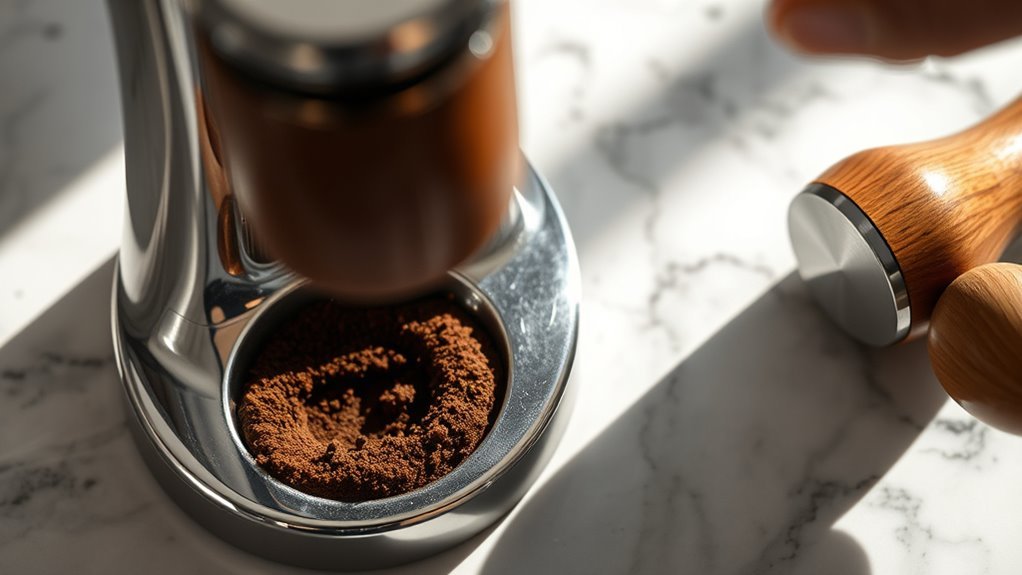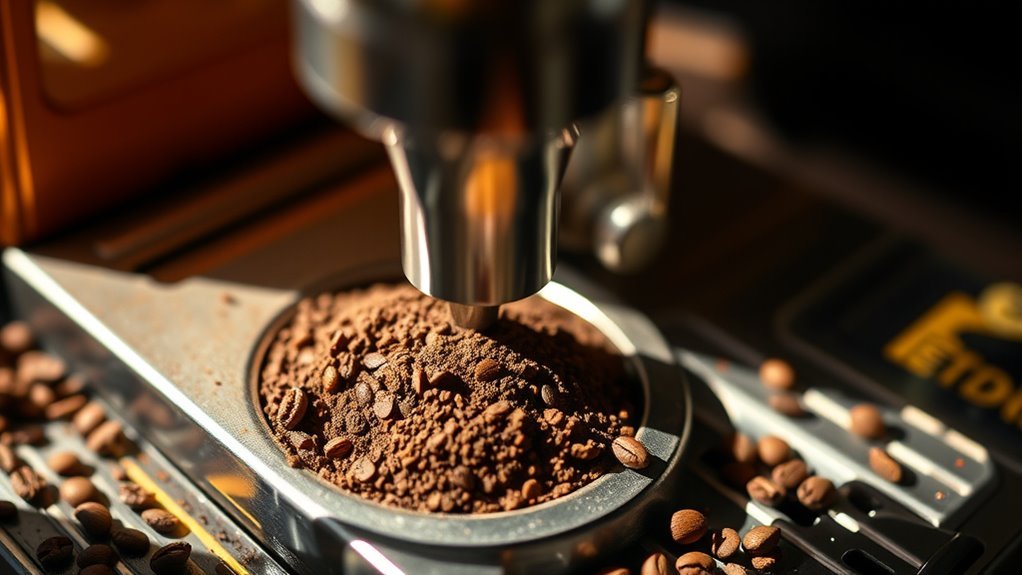The Art of Tamping: A Key to Great Espresso
You hold the key to great espresso with the art of tamping—applying consistent, firm pressure around 30 pounds compacts your coffee grounds evenly, ensuring balanced extraction and rich flavor. Using quality tools like a flat tamper and keeping them clean will enhance your technique. Adjust tamping pressure based on your grind and roast for the best results. Mastering this craft reveals espresso’s full potential, and further nuances can elevate your skills even more.
Understanding the Role of Tamping in Espresso Extraction

Although it might seem like a simple step, tamping plays an integral role in espresso extraction by evenly compressing the coffee grounds to create the perfect resistance for water flow. You see, the tamping history reveals its evolution as a vital technique for controlling pressure variations during brewing. When you apply consistent pressure, you guarantee water is forced through the coffee bed uniformly, avoiding channeling that weakens flavor. Mastering tamping lets you release espresso’s full potential, granting you freedom to craft rich, balanced shots every time. Understanding this process empowers you to refine your technique, adapting pressure to achieve distinct flavor profiles. Tamping isn’t just a routine; it’s the gateway to espresso excellence, where precision meets passion and freedom to explore your own perfect extraction.
Essential Tools for Effective Tamping
Precision is key when it comes to tamping, and having the right tools can make all the difference in your espresso game. To truly master tamping techniques, you need reliable tamping tools that fit comfortably in your hand and provide consistent pressure. A quality tamper with a flat, perfectly sized base guarantees even coffee grounds distribution, preventing channeling. Some prefer stainless steel for durability, while others opt for ergonomic handles to reduce fatigue. A leveler or distributor can also be invaluable, helping you achieve an even coffee bed before tamping. Investing in these essential tamping tools empowers you to refine your technique, reveal the full flavor potential of your coffee, and embrace the freedom to craft espresso that’s uniquely yours every time.
How to Achieve Consistent Tamping Pressure
When you want to pull the perfect shot every time, mastering consistent tamping pressure is essential. Achieving this requires disciplined tamping techniques and mindful pressure calibration. First, focus on applying even, firm pressure—typically around 30 pounds—to create a smooth, compact coffee puck. You can develop muscle memory by practicing with a calibrated tamper or a pressure-sensitive tool, ensuring you apply the same force each time. Avoid guessing your pressure; instead, train yourself to feel the right resistance. Consistency here reveals true freedom in espresso-making, allowing you to control extraction without second-guessing. By committing to precise, repeatable tamping pressure, you empower your espresso to express its fullest potential shot after shot. This is where art meets science, and your journey to espresso mastery begins.
Techniques for Level and Even Coffee Grounds

Mastering just a few key techniques can transform your tamping process by ensuring the coffee grounds are level and evenly distributed. Begin by gently tapping the portafilter’s sides to settle the grounds, promoting uniform coffee density. Next, use a consistent, smooth tamping technique—apply pressure straight down, avoiding any twisting or tilting that disrupts the bed’s evenness. Focus on maintaining a flat, level surface; you can visualize this by checking the rim of the portafilter for any gaps or unevenness. Remember, your goal is a compact, uniform puck that resists channeling during extraction. By honing these tamping techniques, you’ll gain greater control over your espresso’s flavor, embracing the freedom to craft shots with precision and consistency every time.
Common Tamping Mistakes and How to Avoid Them
Why does tamping sometimes feel like a frustrating guessing game? It’s often because you’re unknowingly making common mistakes with tamping pressure and the tamping tools you use. To free your espresso from inconsistency, avoid these pitfalls:
- Uneven Pressure: Applying uneven tamping pressure causes channeling, ruining extraction. Use a level tamp with consistent force.
- Too Light or Too Hard: There’s no one-size-fits-all pressure, but too soft or excessive force disrupts flow. Aim for steady, firm pressure around 30 pounds.
- Dirty or Inappropriate Tools: Dirty tamping tools compromise puck integrity; always clean and use the right size.
- Twisting the Tamper: Twisting after tamping creates cracks—press straight down and lift.
Master these to reclaim control and craft espresso with freedom and precision.
Adjusting Tamping Based on Coffee Grind and Roast
Because grind size and roast level dramatically affect extraction, you’ll need to adjust your tamping technique accordingly. Finer grinds require lighter tamping to avoid over-extraction, while coarser grinds benefit from firmer tamping to guarantee uniform water flow. Darker roasts, being more porous, often need gentler tamping compared to denser light roasts.
| Grind Size | Roast Level | Tamping Pressure |
|---|---|---|
| Fine | Light | Medium (20-25 lbs) |
| Fine | Dark | Light (15-20 lbs) |
| Coarse | Light | Firm (25-30 lbs) |
| Coarse | Dark | Medium (20-25 lbs) |
| Medium | Medium | Medium (20-25 lbs) |
Mastering this balance lets you release espresso’s true freedom and flavor potential.
The Impact of Tamping on Espresso Flavor Profiles

Though tamping might seem like a simple step, its impact on espresso flavor profiles is profound. Your tamping techniques directly influence how evenly water flows through the coffee puck, shaping flavor extraction. Here’s what you need to know:
Tamping shapes espresso flavor by ensuring even water flow and precise extraction through the coffee puck.
- Consistency is key—uniform pressure prevents channeling, ensuring every coffee particle contributes to a balanced shot.
- Pressure matters—too light, and under-extraction leads to sour notes; too heavy, and over-extraction creates bitterness.
- Distribution before tamping—even coffee grounds set the stage for ideal flavor extraction when tamped properly.
- Tamping angle—keep it level; a tilted puck causes uneven flow, distorting the espresso’s taste profile.
Mastering tamping techniques frees you to craft espresso that’s rich, nuanced, and truly your own.
Tips for Practicing and Perfecting Your Tamping Skills
To master tamping, you need to apply consistent pressure every time, ensuring the coffee grounds are evenly distributed before you press. Pay close attention to your tamp’s maintenance; a clean, smooth surface will help you achieve a perfect seal. With focused practice on these elements, your espresso shots will reach new heights of flavor and balance.
Consistent Pressure Application
Mastering consistent pressure when tamping transforms your espresso from good to exceptional. Achieving the perfect tamping pressure and pressure consistency is essential to release the full flavor potential of your coffee. Here’s how you can hone this skill and gain freedom in your espresso crafting:
- Use a calibrated tamper to get a feel for 30 pounds of pressure—this is your benchmark.
- Practice tamping on a bathroom scale to train muscle memory for consistent force.
- Keep your wrist locked and apply even downward pressure, avoiding any twisting motion.
- Develop a steady rhythm; consistency in speed helps maintain uniform tamping pressure.
With these focused steps, you’ll gain control, ensuring each shot captures espresso’s rich, bold essence every time.
Even Coffee Distribution
Even when you apply perfect pressure, uneven coffee distribution can sabotage your espresso’s flavor and extraction. Mastering distribution techniques guarantees the coffee bed is level, preventing channeling that ruins brew consistency. Focus on achieving grind uniformity first; inconsistent grounds make even tamping impossible. Before tamping, gently tap or use tools to spread the grounds evenly, creating a flat, compact surface. This step directly influences espresso quality and showcases your barista skills. By controlling distribution, you allow water to flow uniformly through the coffee bed, releasing rich, balanced flavors. Practice this routinely—your espresso will thank you. Embrace this freedom to experiment and refine your approach; even small tweaks in distribution can elevate your shots from average to exceptional every single time.
Regular Tamp Maintenance
Achieving a perfectly distributed coffee bed sets the stage, but consistent tamping is what truly seals the deal for a balanced espresso shot. Regular tamp maintenance sharpens your skill and guarantees your equipment care prolongs the life of your tools. You want to master this ritual with precision and freedom. Here’s how to practice effectively:
- Set a daily tamp routine—commit to consistent pressure and angle every time.
- Clean your tamper and portafilter regularly—prevent coffee residue buildup that skews tamping quality.
- Check your tamp’s base for wear—replace or polish to maintain a flat, even surface.
- Practice with different grinds and doses—adapt your tamping pressure to the coffee’s texture.
These steps empower you to perfect tamping, blending art and science for espresso excellence.
Frequently Asked Questions
How Often Should I Clean My Tamper?
You should clean your tamper regularly to guarantee ideal tamper maintenance and consistent espresso quality. Ideally, wipe it down after each use to remove coffee grounds and oils, and perform a thorough cleaning weekly. This cleaning frequency prevents buildup that can affect your tamping pressure and flavor extraction. Staying on top of tamper maintenance gives you freedom to craft flawless espresso shots every time, making your coffee ritual both precise and enjoyable.
Can Tamping Affect Espresso Crema Thickness?
Imagine you’re pulling a shot, but your crema looks thin and uneven. That’s often due to inconsistent tamping pressure affecting crema formation. When you apply the right, even pressure, you create a uniform coffee puck, which allows water to flow evenly and extract those oils that form thick, rich crema. So yes, your tamping technique directly influences the crema’s texture and thickness—mastering it gives you freedom to craft espresso just how you like.
Is Tamping Necessary for All Espresso Machines?
Not all espresso machines demand tamping, but mastering tamping techniques gives you control over extraction. You’ll find that consistent tamping pressure helps create even resistance, vital for machines without built-in pressure regulation. While some super-automatics do the work for you, manual or semi-automatic machines rely on your tamping skills. So, if you want freedom to shape your espresso’s profile, learning proper tamping is essential.
What Is the History of Espresso Tamping?
You’ll find that espresso origins trace back to early 20th-century Italy when baristas began refining brewing methods. Tamping techniques evolved as they realized evenly compressed coffee grounds were key to a rich, balanced shot. As espresso culture grew, tamping became an art, revealing flavors and aromas. By mastering these techniques, you’re not just making coffee—you’re embracing a tradition that celebrates freedom in crafting the perfect espresso experience.
Are There Eco-Friendly Tampers Available?
Imagine a tamper crafted by forest elves, whispering sustainability secrets. You’ll be thrilled to know eco-friendly brands now offer tampers made from sustainable materials like bamboo, recycled aluminum, and reclaimed wood. These tampers don’t just press coffee—they press a statement for your freedom-loving soul, letting you savor espresso without guilt. Choosing one means you’re not just crafting great coffee but championing a greener planet, one perfect puck at a time.






